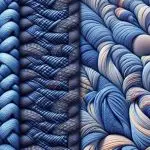When I think about denim, it's the fabric's iconic durability and unique indigo shade that first come to mind. It's fascinating how this material has evolved from robust workwear to a global fashion staple, seamlessly blending into both our everyday wardrobes and high-fashion runways. What's more, the way denim ages, developing a personalized patina over time, really sets it apart from other textiles. But there's so much more beneath the surface, from its twill weave to the cultural impact it has had over the decades. So, let's explore what has kept denim in the spotlight for so long and what the future might hold for this versatile fabric.
Table of Contents
Key Takeaways
- Denim is recognized for its durable 3×1 twill weave construction, enhancing its strength and resilience.
- It is famous for its unique indigo dye process, which allows for a distinct fading pattern over time.
- Denim has evolved from utilitarian workwear to a global fashion staple, symbolizing both innovation and style.
- The fabric's versatility and durability make it a popular choice for various fashion items, especially jeans.
- Denim embodies a canvas for self-expression, offering customization and adaptability to current trends.
Iconic Twill Weave
Denim's iconic twill weave, with its diagonal lines and sturdy 3×1 construction, isn't just about looks; it's the backbone that makes this fabric so durable and beloved. When I first got into the nitty-gritty of what makes denim such a distinctive fabric, the twill weave pattern really stood out. It's not just any pattern; those diagonal lines running across the fabric don't just add texture and visual appeal—they're why your favorite jeans can take a beating and still look great.
Digging deeper, I learned that the 3×1 twill weave means there are three warp yarns for every weft yarn. This isn't a random design choice; it's a deliberate decision that adds incredible strength and resilience to the fabric. As someone who's tough on clothes, I appreciate that kind of durability. Whether it's for workwear that can withstand the rigors of a job site or casual wear that keeps up with my weekend adventures, denim delivers.
And it's not just me and you noticing. The fashion industry has long recognized the unique qualities of denim's twill weave, making it a staple for both high-end designs and everyday essentials. It's clear why this fabric continues to dominate our wardrobes.
Indigo Dye Process
One can't talk about what gives denim its soul without diving into the indigo dye process. It's fascinating to see how this color, deeply rooted in history, plays a major role in the character of denim. Originally, indigo dye came from plants found in India, Africa, and the Americas. But since 1878, we've mostly used synthetic indigo dye. It's cheaper and more accessible, making it a game-changer for the denim industry.
This dye isn't just about slapping on a blue color; it's about layering. The process involves repeatedly dipping the twill fabric to get that rich, deep blue that denim is famous for. And here's the kicker: the way indigo dye adheres to the fabric creates those unique fading properties we all love. Over time, with wear and washing, it fades in a way that gives each piece its own story.
Speaking of washing, manufacturers can manipulate the washing effects to create different finishes. From stone-washed to acid-washed, these techniques all start with the indigo dye process. It's this versatility and the ability to age gracefully that have cemented denim's place in our wardrobes. It's not just fabric; it's art.
Global Fashion Staple
I've always marveled at how denim has woven itself into the fabric of global fashion, becoming a must-have in closets everywhere. Its journey from durable workwear to an iconic fashion staple is a testament to its versatile appeal and the unique attributes of the fabric itself. The indigo blue that gives denim its distinctive look comes from a dyeing process that's as rich in history as the material is in style. This, coupled with the sturdy twill weave, not only enhances its aesthetic appeal but also tells a story of innovation and evolution.
The history of denim is fascinating, stretching back to the mid-19th century when it began its life as a utilitarian garment for hard labor. Fast forward to the 1950s, and it's making waves in the fashion industry, symbolizing rebellion and freedom. Now, it's a global phenomenon. The fact that the global denim market hit US$57.3 billion in 2020 speaks volumes about its enduring appeal. Made primarily from cotton, denim's journey from the gold mines to high fashion runways is a vivid example of how a simple fabric can capture the imagination of people across the world, making it a true global fashion staple.
Durability and Versatility
Although it's best known for its iconic look, denim's real magic lies in its unbeatable durability and versatility. The secret to its tough-as-nails nature? It's all in the twill weave construction. This unique pattern not only gives denim its distinctive appearance but also makes it resistant to the usual wear and tear that would have other fabrics giving up the ghost way too soon.
But don't let its ruggedness fool you; denim's versatility is what's truly remarkable. Thanks to the indigo dyeing process, which sinks deep into the fabric, we're looking at long-lasting color that doesn't fade away at the first sign of a washing machine. This enduring appeal makes denim a canvas for self-expression. Whether it's the classic blue jeans, a customized jacket brimming with patches and embellishments, or distressed to perfection, denim allows for a level of customization that makes each piece distinctly personalized.
It's this combination of durability and the ability to adapt to an array of styles and trends that cements denim as a wardrobe staple. Its resilience against daily use and its chameleon-like quality to blend into high fashion or remain steadfast in its workwear roots showcases why denim continues to be celebrated for its durability and versatility.
Evolution of Jeans
So, let's talk about how jeans have changed over time.
I'll start by looking at where denim pants originally came from.
Then explore how their styles have evolved.
And finally touch on the tech that's changed how they're made.
It's fascinating how something so basic has transformed across decades.
Origins of Denim Pants
Let's dive into how denim pants, initially crafted in the 17th century in Nîmes, France, have evolved into the jeans we know and love today.
Born from the durable twill cloth known as Serge de Nîmes, these pants were dyed with indigo, giving them their distinctive blue hue.
Enter Levi Strauss & Co. and Jacob W. Davis, who revolutionized the denim market in 1873 by patenting riveted work pants. This innovation marked a turning point, transforming denim from mere workwear into an iconic fashion statement.
The denim industry hasn't looked back since, with jeans becoming a timeless staple in wardrobes worldwide. It's fascinating to see how this rugged fabric has woven its way through history, isn't it?
Style Transformations Over Time
Over the years, jeans have gone through an incredible evolution, morphing from basic workwear to an essential piece of fashion. Initially, they were just tough, indigo dye-coated pants for laborers.
Then came a massive shift. In the 1950s, denim started to symbolize casual wear and individual expression. By the 1960s, it wasn't just clothing; it was a statement against the norm, a badge of rebellion and youth culture.
This iconic status has only grown, with style transformations keeping denim blue at the heart of fashion trends. Its versatility and adaptability, coupled with advances in fabric technology, have cemented its position as a timeless wardrobe staple.
Denim's journey from practical to iconic showcases its unique place in the fashion world.
Technological Advancements in Manufacturing
Jeans have seen some incredible tech upgrades, like the shift to twill weave and better dyeing methods, that've truly transformed how we make and wear them. From the get-go, Levi Strauss & Co. were game changers with their riveted denim pants, moving jeans from just workwear to a symbol of rebellion and youth culture. It's the twilled cotton and indigo dye that really set the stage, making denim the go-to fabric for those looking to make a statement.
| Advancement | Impact |
|---|---|
| Twill Weave Fabric | Enhanced durability and comfort |
| Indigo Dye Extraction | Richer, long-lasting color |
| Riveted Joints | Reinforced stress points for workwear |
This shift wasn't just a technical one; it was cultural, embedding denim in the heart of rebellion and individuality.
Cultural Impact
Denim's journey from workwear to wardrobes worldwide showcases its massive cultural impact, especially since the 1950s. It's fascinating how a rugged fabric meant for miners and cowboys transformed into an emblem of fashion and rebellion. I've always been intrigued by the way cultural icons like Elvis Presley and James Dean turned denim into a statement of defiance, embedding it deeply into youth culture. Their influence can't be overstated; they made jeans cool, and suddenly, everyone wanted a pair.
Companies like Levi Strauss were at the forefront, revolutionizing how we view denim. They didn't just sell jeans; they sold an identity, a piece of rebellion stitched into every seam. It's incredible to think about the role these brands played in catapulting denim from practical workwear to a fashion staple.
Now, denim's not just clothing; it's a cultural phenomenon, a canvas for personal expression that transcends generations. Its versatility and iconic status have firmly planted it in our collective wardrobes, making it clear that denim's more than just fabric. It's a fashion statement, a slice of history, and for many of us, a second skin.
Future Innovations
As we look toward the future, it's clear that the denim industry is making a major shift toward sustainability and eco-friendly practices. Brands are now weaving sustainable practices into the very fabric of denim production, driven by a growing consumer demand for fashion that's kind to our planet. It's fascinating to see both premium and fast-fashion denim lines embracing sustainability as a core feature, proving that eco-friendly can also be trendy.
The push for environmentally friendly dyeing and finishing processes is revolutionizing how we think about crafting our beloved denim. This isn't just a niche trend; it's a widespread movement towards reducing the environmental footprint of denim production. We're talking about innovations that conserve water, reduce chemical use, and cut down on energy consumption—all without sacrificing the classic styles we've come to love.
Sustainable denim is no longer a lofty goal; it's becoming the standard. The future of denim lies in striking the perfect balance between maintaining its timeless appeal and embracing eco-friendly technologies. It's an exciting time to be a denim lover, knowing that our favorite jeans can help pave the way for a more sustainable fashion industry.
Frequently Asked Questions
What's so Special About Denim?
I've always wondered what makes denim stand out. It's super durable, fades beautifully over time, and its twill pattern is quite distinct. Plus, it's incredibly versatile, fitting into almost any style. Truly a timeless classic!
What Does Denim Symbolize?
I'd say denim symbolizes a mix of durability, rebellion, and versatility. It's evolved from workwear to a fashion must-have, expressing individuality and a laid-back vibe that's universally recognized and cherished across cultures.
What Is Denim Also Known As?
I've learned that denim's also called "serge de Nîmes," named after its French origin. It's fascinating how its journey from Nîmes to global popularity shaped its identity, reflecting its rich history and versatility.
What Is Denim Most Commonly Used For?
I've noticed denim's mostly used for crafting jeans, jackets, and other casual wear. Its durability and style versatility make it a wardrobe staple. Plus, it ages well, adding character to every piece over time.







